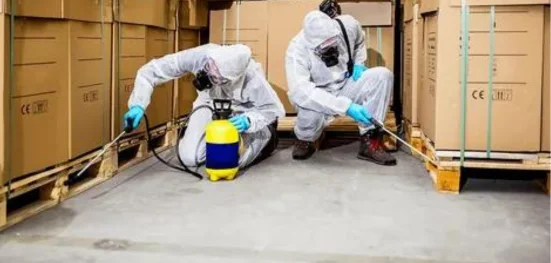
As the sun set, a young family settled in for the evening. They were unaware of the unwelcome guests in their home. A faint scratching sound caught their attention, revealing a mouse problem. Many homeowners face this common scenario. But with the right knowledge and strategies, you can eliminate mice and prevent them from taking over your space.
Key Takeaways
- Understanding the identification and behavior of house mice is crucial for adequate control.
- Implementing prevention methods and sealing entry points can help deter mice from entering your home.
- Both natural and chemical solutions are available to eliminate mice, including essential oils and professional-grade poisons.
- Knowing when to call a professional exterminator can save time and ensure long-term, mouse-free living.
- Maintaining a clean, clutter-free environment and regularly inspecting for signs of infestation are key to ongoing mouse prevention.
Mouse Activity Patterns and Habits
- House mice are primarily active at night, starting at dusk.
- They live in colonies and have a social hierarchy.
- Mice are great climbers and can find their way into homes through small openings.
- They eat a variety of foods, including grains, fruits, vegetables, and pet food.
Signs of Mouse Infestation in Your Home
Spotting mouse infestation signs is the first step to solving the problem. Look out for:
- Droppings – Small, dark, rod-shaped fecal pellets in active areas.
- Gnaw marks – Damage to food packaging, furniture, or wires from chewing.
- Nesting materials – Shredded paper, fabric, or insulation used for nests.
- Sounds – Noises, especially at night, as mice move around.
Seeing these signs means quickly stopping the problem and protecting your home.
How Can You Get Rid of Mice and Control Methods
Dealing with mice can be frustrating. But, with the proper steps, you can get rid of them. You can try it yourself or get help from a mouse exterminator. There are many ways to keep your home mouse-free.
DIY Mouse Prevention Techniques
To prevent mice from entering your home, start by checking it. Seal any holes or gaps. You can also use traps or natural deterrents, like essential oils.
Professional BP Pest Control Solutions
If mice keep coming back, consider getting an exterminator. They know how to find and fix the problem, and they might use mouse poison or humane traps.
DIY Mouse Control Methods Professional Pest Control Solutions
- Seal entry points
- Use traps
- Apply natural deterrents
- Comprehensive inspection
- Targeted mouse poison
- Humane trapping and removal
Whether you do it yourself or get help, the goal is to solve the problem. Use a mix of prevention and control. With the proper steps, you can keep your home mouse-free.
Natural and Chemical Mouse Control Solutions
Managing a mouse problem in your home requires several different steps. You can use natural methods or chemical products, each with its benefits.
Essential Oils and Natural Deterrents
Peppermint oil and citronella are known to keep mice away. Their strong smells can make mice uncomfortable. Try soaking cotton balls in these oils and placing them around your home. Other natural methods include ultrasonic or electromagnetic devices. These devices make sounds and magnetic fields that mice don’t like, but they might not work for big mouse problems.
Professional Mouse Poison Options
Professional-grade mouse poisons can help with challenging mouse issues. These are stronger than what you can buy at stores. But use them carefully to keep your family and pets safe.
DIY Mouse Repellent Recipes
Another option is to create your homemade mouse repellents. Mix essential oils with water or vinegar and spray them. You can also use spices like cayenne pepper or cinnamon to keep mice away. Choosing the right mouse control method depends on the severity of the problem and your preferences. Try different natural and chemical options to find the best mouse deterrent for your home.
Sealing Entry Points and Mouse-Proofing Your Home
Effective mouse control starts with finding and sealing entry points in your home. Mice can climb and squeeze through tiny openings, like a dime. Blocking these gaps is key to keeping mice out of your home.
Using spray foam is a top way to mouse-proof your home. This material can be applied to cracks and gaps around pipes and wires. It creates a firm barrier that mice can’t chew through. Spray foam expands to fill big spaces and lasts a long time.
Here are more ways to mouse-proof your home:
- Check the outside of your home and seal any significant cracks or holes, especially around pipes, windows, and doors.
- Put weather stripping and door sweeps to block gaps at the bottom of doors and windows.
- Use fine mesh screens to cover vents, chimneys, and openings to keep mice out.
- Keep food, including pet food, in airtight containers or cabinets to remove food sources for mice.
- To stop mice from nesting, keep your home clean and clutter-free, especially in storage units or attics.
Sealing entry points and mouse-proofing your home can prevent mice in walls and other infestations. This will make your home safer and more comfortable for your family.
Professional Extermination vs. DIY Mouse Control
Homeowners have a choice when dealing with mice professional extermination or DIY methods. Knowing the advantages and disadvantages of each can help you choose the right approach for your mouse problem.
When to Call a Professional Exterminator
A professional BP Pest Control exterminator mice service is often the best choice for severe mouse infestations. They use more potent products and tools to get rid of mice quickly. They also know how to find and seal entry points, helping to keep your home mouse-free long-term.
Long-term Mouse Prevention Strategies
Long-term prevention is key whether you go for professional or DIY mouse control. This includes sealing entry points, removing food sources, and regularly checking for mouse signs.
- Seal cracks, holes, and entry points around your home using caulk, steel wool, or other materials.
- Store food in airtight containers and keep your kitchen clean and free of crumbs or spills.
- Regularly check attics, basements, and other areas for signs of mouse activity, such as droppings or nesting materials.
You can keep your home mouse-free and maintain a pest-free environment using effective control methods and proactive prevention.
Final Words For How can you get rid of mice?
It would help if you had a solid plan to control and eliminate mice in your home. Knowing how to spot and understand mouse behavior enables you to act fast to stop and remove them effectively. There are many ways to control and eliminate mice in your home. You can try natural methods, make your repellents, or hire professionals. It’s also crucial to seal any holes and keep up with prevention to keep mice away for good. This article offers tips to help you manage the situation. Following these steps, you can keep your home safe from mice and their health and property risks.
FAQ For How Can You Get Rid of Mice
How can I identify signs of a mouse infestation in my home?
Look for mouse droppings, see mice or their tracks, and hear noises in walls or the attic. Also, check for gnaw marks on food or other items.
What are some effective natural and homemade remedies for getting rid of mice?
Use natural repellents like peppermint oil, cayenne pepper, and essential oils. Homemade traps with peanut butter, oats, and vinegar can also work well.
When should I consider hiring a professional exterminator to solve a mouse problem?
Call a pro-BP Pest Control if mice keep returning and you can’t handle it. They have the skills and tools to get rid of mice for good.
How can I effectively mouse-proof my home and prevent future infestations?
Seal entry points and remove food sources. Use steel wool or spray foam to block access. Regular checks and upkeep keep your home mouse-free.




